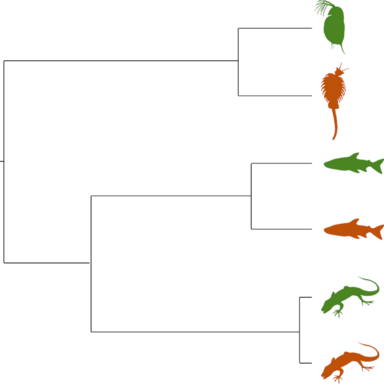Project 18.2

- PhD student: Annika Djolai (née Müller)
- Supervisor: Ann Kathrin Huylmans
- Co-Supervisors: Peter Baumann
- Further TAC-members: René Ketting , Michail Rovatsos (Charles University, Prague)
- Research Group
Sex is determined by genetic or environmental sex determination, resulting in two very different phenotypes, male and female. These phenotypic differences mostly result from differential gene expression which allows the two sexes to achieve their approximate respective fitness optima.
I investigate how sex determination systems transition into each other. Furthermore, I would like to find common effects on genome evolution and gene regulation in organisms with environmental as compared to genetic sex determination.
Most eukaryotes reproduce sexually – a mechanism that allows for recombination and therefore faster evolution. Although the separation of sexes is not necessary for sexual reproduction, many multicellular organisms have developed sexually specialised phenotypes. Here, the organism’s sex can be determined via two different systems: genetically, for example, by sex chromosomes, or environmentally. These sex determination systems are not necessarily mutually exclusive and rather represent a continuum within which the systems can transition into each other.
The two sexual phenotypes differ in physiology, ornamentation, size, immunity, and behaviour. Most of these differences arise due to differential gene expression between the sexes. However, when fitness optima differ between sexes for a shared trait and tight regulation does not let one or both sexes reach their optimum phenotype, sexual conflict is created.
In species with sex chromosomes, sexual conflict can at least partially be resolved via transloction of genes to the sex chromosomes. However, this is not possible in species with environmental sex determination where males and females share their entire genome. In these species, gene regulation plays an even more pronounced role in the formation of the different phenotypes. Some possibilities to resolve sexual conflict other than moving genes to the sex chromosomes are known. This includes the duplication and subsequent subfunctionalisation of genes. Here, one copy can primarily be used in males and the other in females.
In my project, I am investigating how genome evolution and gene regulation differ between organisms with environmental and genetic sex determination. As I am interested which mechanisms are evolutionarily conserved, I will compare organisms of these two modes of sex determination among highly divergent taxa, including crustacean, reptile, and fish species. The results of my project could shed light on fundamental genetic and regulatory mechanisms involved in resolving sexual conflict and how the mode of sex determination contributes to the evolution of both gene repertoire and gene regulation.
In a second part of my project, I will investigate the evolutionary transition between sex determination systems. A system that I find especially intriguing among the aforementioned taxa is the evolution of sex determination in wild and domesticated forms of zebrafish. Wild zebrafish have been shown to determine their sex via the genetic ZW system. Interestingly, these sex chromosomes were lost in captivity, leading to the establishment of polygenic sex determination in the domesticated strains. I would like to better understand the mechanisms and consequences of this rapid loss of sex chromosomes, i.e. differences in sex-biased genes and gene expression.
